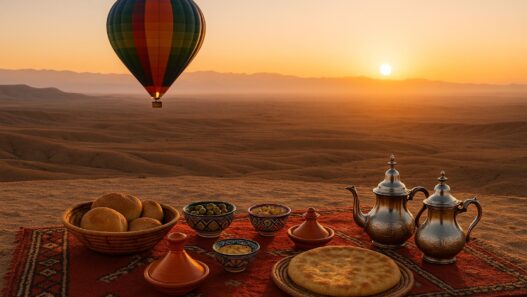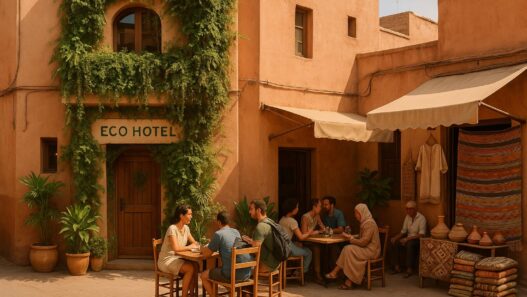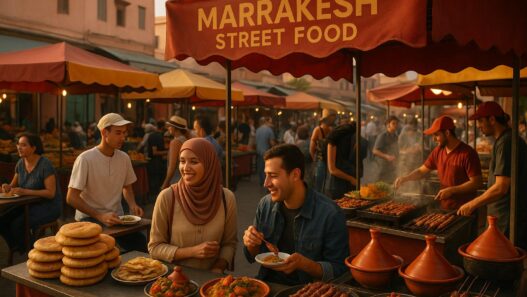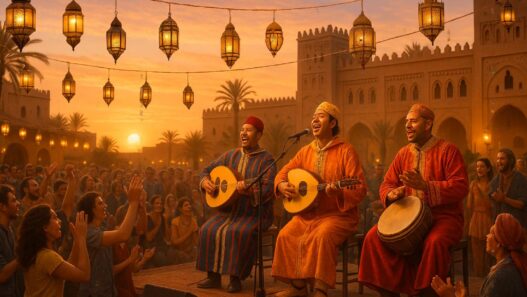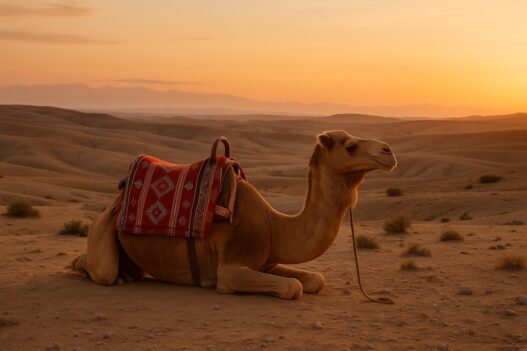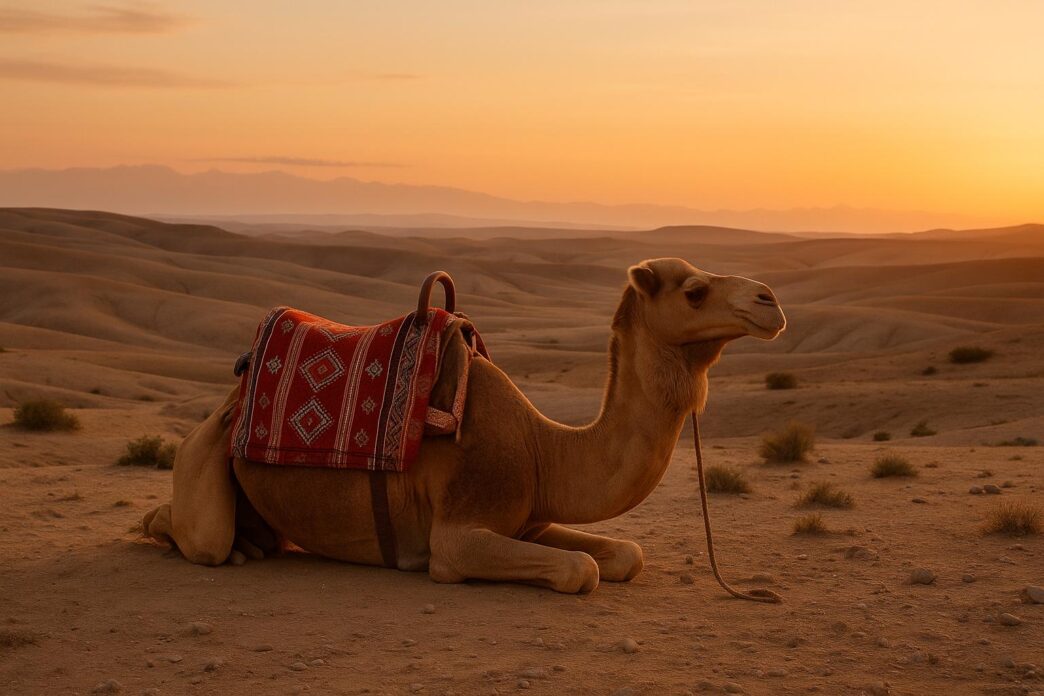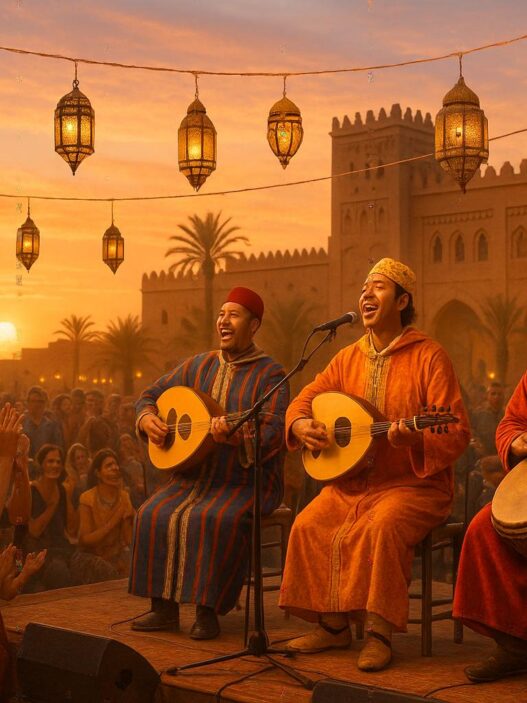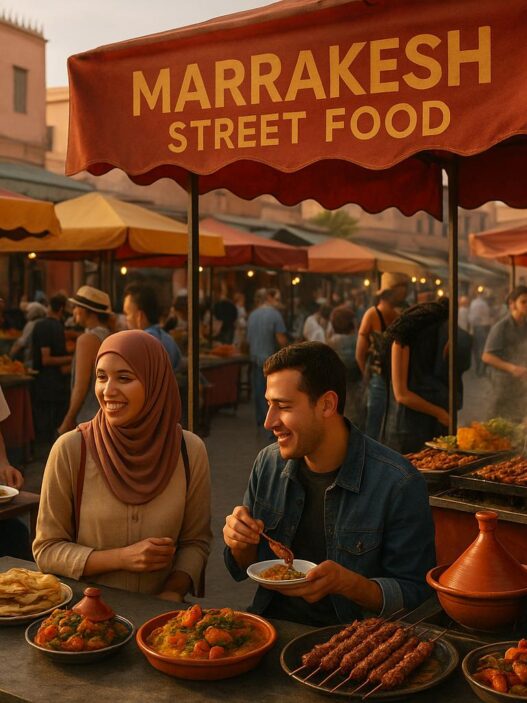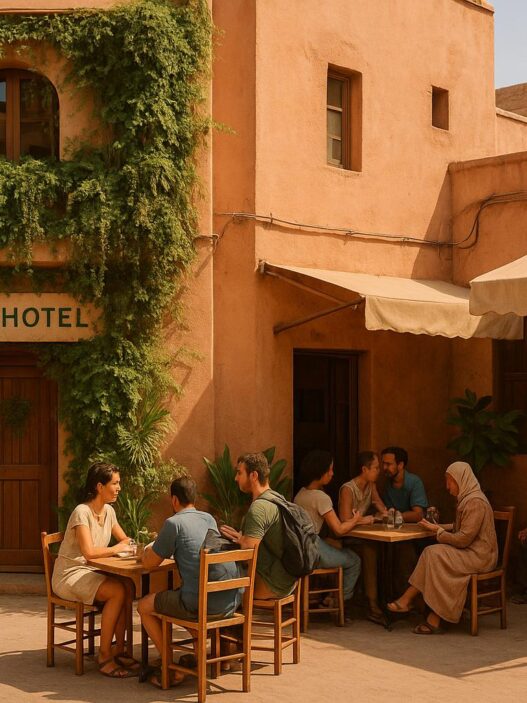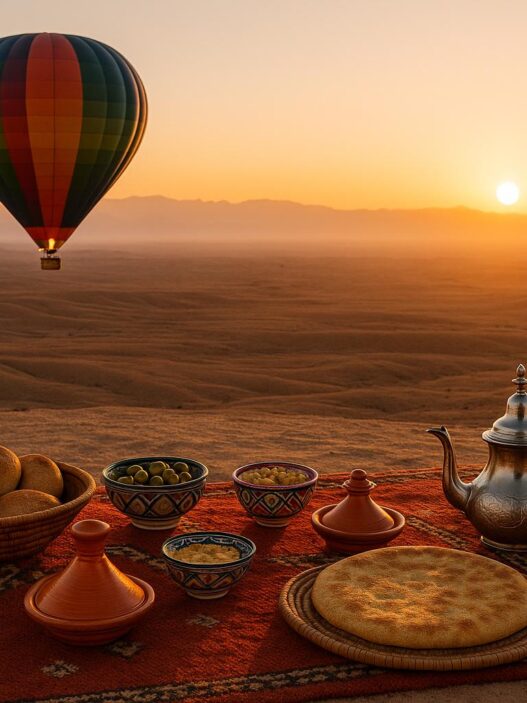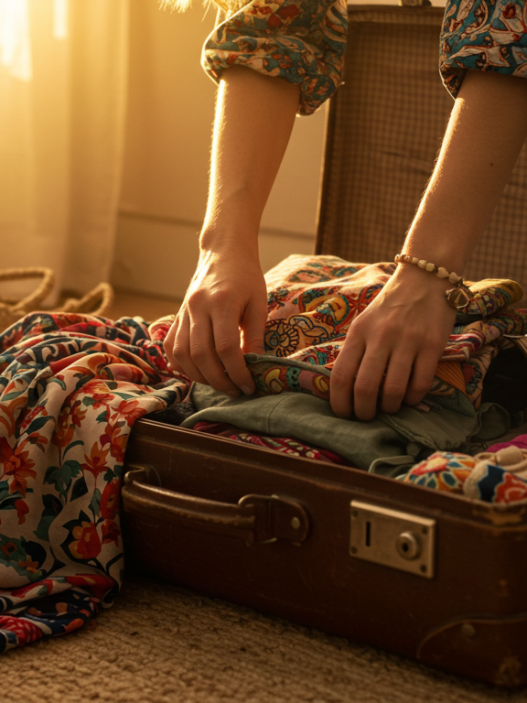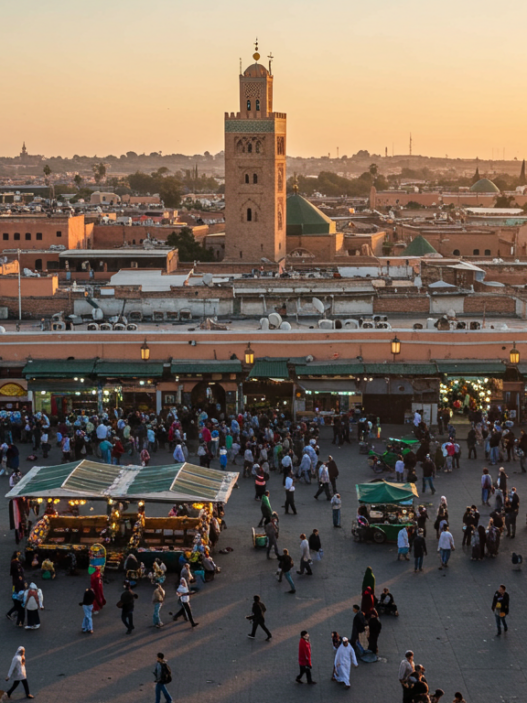If you’re in Marrakesh and want a desert experience without the lengthy Sahara journey, the Agafay Desert is your answer. Located just 25 miles southwest of the city, it offers a rocky, Mars-like landscape perfect for short adventures. Activities like camel rides, quad biking, and stargazing are popular, and most trips fit into a 7–8 hour window. With options for every budget, from $25 group tours to luxury camps, Agafay combines convenience with unforgettable views of the Atlas Mountains.
Key Highlights:
- Travel Time: Only 45–60 minutes from Marrakesh.
- Activities: Camel rides (~$25), quad biking (~$50+), hot air balloons, and desert dining.
- Best Times to Visit: Spring and autumn for mild weather.
- Costs: Group tours start at $25, private transfers range from $40–$80, and luxury camps begin at $100 per night.
- What to Pack: Layers for temperature swings, sun protection, sturdy shoes, and plenty of water.
Quick Tip: Book in advance, especially for sunset tours or peak seasons, and carry cash for tips and small purchases. Whether you’re seeking adventure or a relaxing escape, Agafay offers a desert experience close to the city.
Getting to the Agafay Desert from Marrakesh
Distance and Travel Time
The Agafay Desert lies about 25 miles (30–40 km) southwest of Marrakesh, making it a short trip of 45 minutes to an hour by car, depending on traffic. To avoid delays, consider starting your journey early in the day or mid-afternoon when the roads are less congested. Once you’re ready to go, you’ll find several transportation options to match your preferences.
Transportation Options
Private Transfers
If you value convenience and comfort, private transfers are a solid choice. These include hotel pickup and drop-off with professional drivers. Prices range from $40 to $80 per car, while premium services can cost between $60 and $150. You can book through online travel platforms, your hotel concierge, or local taxi services.
Group Tours
For those on a budget, group tours are a great alternative. They combine transportation with activities and meals. Basic packages are priced at $25–$50 per person, while more inclusive options – featuring camel rides, quad biking, and traditional meals – range from $60 to $120 per person. Many tour companies, hostels, and travel agents in Marrakesh offer these packages.
Taxis
Taxis are a flexible option if you prefer to set your own schedule. Be sure to negotiate and agree on the fare beforehand. Rates typically range from $30 to $50 for a round trip, but some drivers may charge $50 to $90 depending on waiting times and your destination.
Car Rentals
For full independence, renting a car lets you explore at your own pace. Daily rental rates range from $30 to $60, not including fuel. A standard car is suitable for most desert camps, but if you’re planning to venture into more rugged terrain, consider renting a 4×4.
Quad Bike Rentals
Looking for an adventurous way to experience the desert? Quad bike rentals let you explore with a bit of thrill. Half-day rentals cost $50–$80 and often include guided routes.
Camel Trekking
For a more traditional desert experience, camel trekking is available at $40–$70 per person. Keep in mind, though, that this option takes longer than motorized transport.
After choosing your preferred mode of transport, it’s time to focus on booking the best experience.
Booking Considerations
Plan ahead, especially if you’re interested in sunset tours or weekend trips, as these tend to fill up quickly. When booking, confirm whether your guide speaks your preferred language and clarify pricing details. Prices are typically listed in Moroccan dirhams (MAD) with approximate USD conversions. Some operators accept credit cards, but cash is often preferred. Tipping is customary, usually around 10–15% of the service cost.
Double-check what’s included in your package. While tours often cover meals, activities, and entrance fees, private transfers generally only include transportation. Knowing what to expect will help you make the most of your time in the Agafay Desert.
Lastly, pack appropriately. Summer temperatures can exceed 100°F, while winter nights can get quite chilly. Be prepared for the desert’s dramatic temperature swings, no matter the season.
Worth the HYPE? Agafay Desert Sunset, Camel Ride, and Dinner Tour from Marrakesh, Morocco – Day trip
Top Activities in the Agafay Desert
The Agafay Desert, with its striking, moon-like rocky landscape, offers a variety of activities for all types of travelers. Whether you’re chasing adventure or looking to immerse yourself in Moroccan traditions, the desert provides a unique experience at every turn.
Camel Rides
Exploring the Agafay Desert on camelback is a classic way to soak in the scenery. At around $25 per person, these rides offer a glimpse into traditional desert travel. To avoid the intense heat, it’s best to plan your ride for early morning or late afternoon. If you’re concerned about animal welfare, look for operators with positive reviews regarding ethical practices. Camel rides usually last 30 minutes to an hour, giving you plenty of time to enjoy the stunning views and learn about the Berber way of life. For a faster-paced adventure, quad biking is another exciting option.
Quad Biking Adventures
For those craving a bit of adrenaline, quad biking is a thrilling way to tackle the desert’s rugged terrain. Prices range from $50 to $135 depending on the tour length and group size. Riders must be at least 16 years old, but no driver’s license is required. Most tours last one to two hours and can often be paired with other activities for a full desert experience.
Hot Air Balloon Rides
A sunrise hot air balloon ride offers a breathtaking view of the Agafay Desert and the distant Atlas Mountains. These rides are highly popular during peak seasons, so booking ahead is essential. Flexible scheduling is also recommended, as weather conditions can affect availability. Reputable operators focus on safety with well-maintained equipment and experienced pilots. Many packages include extras like pre-flight refreshments and post-flight celebrations, making the experience even more special.
Village Visits and Guided Tours
Visiting nearby Berber villages adds a cultural layer to your desert adventure. Guided tours provide a window into the daily life, architecture, and crafts of rural Morocco. Be sure to dress modestly and ask permission before photographing locals. Some tours also include short desert hikes, where you can learn about the area’s plants, geology, and traditional navigation techniques. After a day of exploring, you can wind down with an unforgettable desert dining experience.
Desert Dining
Dining under the stars in a desert camp is an experience you won’t forget. Traditional Moroccan meals often feature tagines, couscous, and grilled meats, all prepared using age-old methods. Popular dishes include lamb or chicken tagines, vegetable couscous, and fresh bread, served with refreshing mint tea. Many operators can accommodate dietary preferences, such as vegetarian, vegan, or gluten-free options, if informed in advance. Desert camps often enhance the evening with Berber tents, campfires, and live performances of drumming and folk dancing. And with the desert’s clear skies, stargazing becomes the perfect way to end your day.
What Makes the Agafay Desert Different
The Agafay Desert offers a unique escape, setting itself apart from the more famous Sahara. While the Sahara often comes to mind when imagining a Moroccan desert adventure, Agafay delivers a completely different experience, especially suited for day trips and shorter visits.
Landscape and Atmosphere
Agafay is often called a "stone desert" because of its rugged, rocky terrain. Instead of vast sand dunes, you’ll find rolling hills, dry riverbeds, and rocky plateaus that stretch endlessly across the horizon. Spanning about 17,000 hectares, this desert creates a surreal, moonlike landscape that seems to transform as the light changes throughout the day. The varying elevations and textures give the area a striking, almost otherworldly appearance, often compared to the surface of Mars.
This distinct terrain not only defines Agafay’s character but also provides countless opportunities for stunning photographs.
Views and Photo Opportunities
Agafay’s rocky hills provide a dramatic contrast to the distant, snow-capped Atlas Mountains. This juxtaposition creates a breathtaking backdrop that’s perfect for photography. As the sun moves across the sky, shadows dance across the rocky formations, and during sunset, the landscape glows with warm, golden tones, with the Atlas Mountains silhouetted in the distance. At night, the lack of light pollution makes for incredible stargazing.
If you visit after winter rains, you might even see parts of the desert come alive with wildflowers and grasses, adding unexpected bursts of color to the rocky scenery. For those planning to explore, sturdy shoes and preparation for dusty conditions are essential.
These dramatic views and changing conditions make Agafay a photographer’s dream and a destination worth planning for.
Best Times to Visit and What to Pack
Agafay’s appeal changes with the seasons, offering something special year-round. Spring (March to May) and autumn (September to November) are particularly inviting, with mild temperatures and fewer crowds.
| Season | Temperature Range | Highlights | Packing Tips |
|---|---|---|---|
| Spring (Mar-May) | 68–82°F (20–28°C) | Wildflowers, pleasant hiking | Light layers, sun hat, sturdy shoes |
| Summer (Jun-Aug) | 100–113°F (38–45°C) | Stargazing, sunrise/sunset views | Breathable clothing, extra water, sun protection |
| Autumn (Sep-Nov) | 72–90°F (22–32°C) | Adventure activities, local experiences | Comfortable layers, hiking boots |
| Winter (Dec-Feb) | Day: 59–68°F (15–20°C), Night: 41–50°F (5–10°C) | Quiet atmosphere, fireside evenings | Warm layers, jacket for chilly nights |
Summer can be intense, with temperatures often climbing above 104°F (40°C). However, the season offers tranquil stargazing and unforgettable sunrise and sunset moments. Winter, on the other hand, brings cooler days and crisp nights, creating a peaceful, almost magical ambiance. No matter the season, pack sturdy footwear and dress in layers to handle the desert’s temperature swings, especially as the sun sets and the air cools rapidly.
sbb-itb-fa26f1f
Practical Tips for Your Day Trip
Planning a day trip to the Agafay Desert? A little preparation goes a long way in ensuring your adventure is both enjoyable and hassle-free. With its rugged terrain and dramatic temperature changes, the desert demands thoughtful packing and preparation.
What to Wear and Bring
Dressing for the desert is all about comfort and practicality. Lightweight, breathable clothing made from natural fibers like cotton or linen works best for keeping cool in the daytime heat. Loose-fitting designs allow for better air circulation. If you’re planning activities like camel riding or sandboarding, opt for flexible, protective bottoms such as leggings or joggers. Don’t forget a light sweater or a warm fleece jacket – desert mornings and evenings can be surprisingly chilly.
Sun protection is non-negotiable. A wide-brimmed hat or a peaked cap will shield your face and neck, while a long scarf can double as protection against both sun and wind. For a more authentic touch, consider a traditional Berber Touareg turban.
Footwear should match the terrain. Durable walking boots or sports sandals are ideal for rocky paths, but avoid shoes with mesh, as they can let in sand. Bring socks to prevent blisters and pack flip-flops for relaxing around camp areas. Test your footwear beforehand to ensure it’s comfortable for extended wear.
Other essentials include sunglasses, SPF 30+ sunscreen, and high-SPF lip balm – UV rays can still be intense even on cloudy days. Pack these items in a small, easy-to-carry backpack, especially if you’ll be riding camels.
Hydration is key. Bring at least 2 liters (about 0.5 gallons) of water, and consider packing extra if the weather is particularly hot. Wet wipes are handy for refreshing yourself and dealing with sand, while a power bank ensures your devices stay charged in camps with limited electricity. Don’t forget your camera for capturing the stunning desert views, and include a basic first-aid kit in your bag.
Layering your clothing is a smart way to handle the temperature swings throughout the day. Also, bring a separate bag for dirty or dusty clothes and ensure you have enough cash and proper payment methods for remote desert areas.
Currency and Payment Tips
Cash is king in Morocco, especially in remote areas like the Agafay Desert. Over 70% of transactions in the country are cash-based, and this reliance is even stronger in rural regions. While established tour operators may accept credit cards for bookings, you’ll need cash for smaller purchases, tips, and local vendors. The local currency is the Moroccan dirham (MAD), and it’s wise to carry small bills for convenience.
Contactless payments are growing in cities, but they’re not yet common in the desert. A good approach is to use cards in urban areas and rely on cash for everyday expenses and tipping. Notify your bank about your trip to avoid any issues with blocked cards, and exchange money at official bureaus or withdraw dirhams from ATMs in Marrakesh before heading out.
Health and Safety Considerations
Staying healthy in the desert requires extra care. Aim to drink 3–4 liters of water daily to combat dehydration caused by the arid conditions.
Sun protection is a must. Apply broad-spectrum sunscreen (SPF 30 or higher) every two hours, wear UV-blocking sunglasses, and keep your head covered with a hat or scarf. Limit alcohol consumption, as it can dehydrate you further.
If you’re planning to try adventure activities like quad biking or camel riding, pay close attention to safety briefings. Professional operators prioritize your well-being, as highlighted by Agafay Day Pass:
"Your safety is our top priority at Agafay Day Pass."
Desert weather can be unpredictable, so check the forecast before your trip. Be prepared for sudden temperature drops, unexpected rain, or dust storms that can reduce visibility and make conditions challenging. Lastly, remember to travel responsibly to protect Agafay’s delicate environment.
Responsible Tourism
Your visit to Agafay can make a difference. Supporting local businesses provides economic opportunities for Berber communities. Choose tour operators who collaborate with local guides, source meals from nearby villages, and contribute to community development projects.
Respect local customs when visiting villages or interacting with residents. Dress modestly, ask permission before taking photos, and show an interest in learning about Berber traditions. Even small gestures, like using basic Arabic or Berber greetings, can create meaningful connections.
Environmental care is equally important. Stick to designated paths to prevent erosion, pack out all your trash, and avoid disturbing the desert’s fragile ecosystem. Though it may seem barren, the desert is home to unique plant and animal life that can take years to recover from damage.
Water conservation is critical in this arid region. Use water sparingly during meals and personal hygiene, and support accommodations that practice water-saving measures. When shopping for souvenirs, buy directly from local artisans to ensure your money benefits the community and helps preserve traditional crafts. By making mindful choices, you can enjoy Agafay’s beauty while helping to preserve it for future travelers.
Pros and Cons of Agafay Desert Day Trips
Agafay Desert offers a mix of benefits and challenges. Knowing what to expect can help you decide if it aligns with your plans for exploring Morocco.
One of Agafay’s standout features is its close proximity to Marrakesh. Unlike the Sahara dunes at Merzouga, which involve a 9–10 hour drive, Agafay is just 45–60 minutes away. This makes it a great option for travelers on tight schedules.
However, this convenience comes with a compromise. Agafay is a stone desert, not the sandy, golden dunes many associate with Morocco. Its rocky, almost lunar landscape has a striking appeal, but it may not meet the expectations of those dreaming of the Sahara’s iconic sandscapes.
Here’s a quick breakdown of Agafay’s key advantages and limitations:
Comparison Table
| Pros | Cons |
|---|---|
| Close to Marrakesh: Just a short drive away (45–60 minutes) compared to the Sahara’s 9–10 hour journey | No sand dunes: Features rocky terrain instead of classic desert sands |
| Time-efficient: Ideal for half-day or full-day trips | Can feel crowded: Popularity means busier spots during peak times |
| Variety of activities: Options include camel rides, quad biking, hot air balloon rides, and stargazing | Extreme temperatures: Summers can exceed 95°F (35°C), while winter nights dip below 41°F (5°C) |
| Affordable trips: Day trips start at $35–40, and budget overnight stays from $79 | Price variation: Luxury options range widely, from $150 to $400 per person |
| Breathtaking sunsets: Minimal light pollution makes for stunning views | Rough terrain: Unpaved roads can be difficult without a 4×4 vehicle |
| Luxury glamping: Upscale desert camps are available | Tourist traps: Some tours include stops at shops aimed at extra spending |
Agafay day trips are a great fit for first-time visitors to Morocco, travelers on tight schedules, or those seeking a mix of luxury and adventure without a long journey. Photographers will appreciate the rugged beauty, while budget travelers can enjoy accessible desert experiences without breaking the bank.
On the flip side, if you’re specifically looking for classic sand dunes, have the time for a Sahara trip, or plan to visit during the scorching summer months, Agafay might not be the best choice. Additionally, those seeking total solitude should be aware that Agafay’s rising popularity can mean busier conditions, especially on weekends.
Despite its limitations, Agafay offers an accessible and memorable desert escape. By keeping expectations realistic and appreciating its rocky charm, convenience, and wide range of activities, you can enjoy a fulfilling alternative to the Sahara. Use these insights to decide if Agafay matches your vision of a desert adventure.
Conclusion: Making the Most of Your Agafay Day Trip
Here’s how to make the most of your adventure to the Agafay Desert.
Timing is everything. Aim to visit during spring (March–May) or autumn (October–November) when the weather is more comfortable. Pack smart – refer to the tips mentioned earlier to ensure you’re ready for the desert environment. Choose tour operators with strong reviews and experienced local guides to enhance your trip. Many activities offered through GetYourGuide are highly rated and worth exploring.
Safety is key. If you’re planning activities like quad biking, always share any medical conditions with your guide beforehand and pay close attention to safety instructions.
Budgeting helps too. Half-day tours generally cost between $30–40 per person, while full-day trips with meals range from $60–100. For those considering an overnight experience, luxury camps are available starting at $100 and can go up to $300 per night. Booking early not only secures your spot but might also save you some money.
Respecting local customs will enrich your experience. Dress modestly, ask for permission before taking photos of locals, and learn a few simple Arabic or Berber greetings to connect with the community. Carry cash for tips and small purchases, as credit cards may not be accepted in remote areas.
The Agafay Desert offers a unique charm with its rocky landscape – different from the Sahara but equally captivating. Its proximity to Marrakech makes it an accessible destination, filled with authentic activities, stunning photo opportunities, and meaningful cultural interactions. Whether you’re a thrill-seeker or a traveler soaking in the scenery, Agafay fits seamlessly into most itineraries.
Keep an eye on the weather and stay flexible with your plans. With thoughtful preparation and an open mind, your Agafay day trip is sure to be a highlight of your Moroccan adventure.
FAQs
How is the Agafay Desert different from the Sahara Desert, and which is better for a short trip from Marrakesh?
The Agafay Desert, just a short 30–45 minute drive from Marrakesh, is a rocky and arid destination that’s perfect for a quick getaway. Whether you’re looking to enjoy camel rides, quad biking, or an evening under the stars, it offers plenty of adventure without the need for a long trip.
On the other hand, the Sahara Desert is renowned for its towering sand dunes and sweeping vistas. However, reaching this iconic destination requires a much longer journey – typically around 9 hours from Marrakesh – making it better suited for multi-day trips rather than a brief visit.
If you’re short on time, the Agafay Desert provides a convenient and memorable experience. But if you can spare a few days, the Sahara’s breathtaking dunes promise an adventure you won’t forget.
How do I decide between a group tour and a private transfer for an Agafay Desert trip?
When planning your Agafay Desert trip, deciding between a group tour and a private transfer comes down to your budget, comfort needs, and schedule preferences.
Group tours are a budget-friendly option and a great choice if you enjoy meeting fellow travelers and sharing experiences. These tours typically stick to a fixed itinerary, which can be convenient but may not offer much flexibility.
Private transfers, on the other hand, offer a more personalized and comfortable experience. You can design your own schedule and enjoy a trip tailored to your preferences, making this option perfect for those who value privacy and convenience. Think about what’s most important to you – saving money, socializing, or having more control over your trip – before making your choice.
How can I make sure my Agafay Desert visit supports local communities and promotes sustainable tourism?
To make your trip to the Agafay Desert a meaningful one, consider choosing eco-friendly tours and accommodations that prioritize hiring local staff and sourcing goods from nearby businesses. Staying in traditional desert camps or taking part in activities led by the community are excellent ways to directly support the local economy.
Show respect for the local way of life by learning a few simple phrases in Arabic or French and joining in on cultural activities like traditional music performances or cooking classes. Steer clear of activities that could harm the environment, such as off-road driving in delicate areas, and always stick to Leave No Trace principles. Thoughtful planning can help you enjoy an unforgettable experience while making a positive difference in the region.



